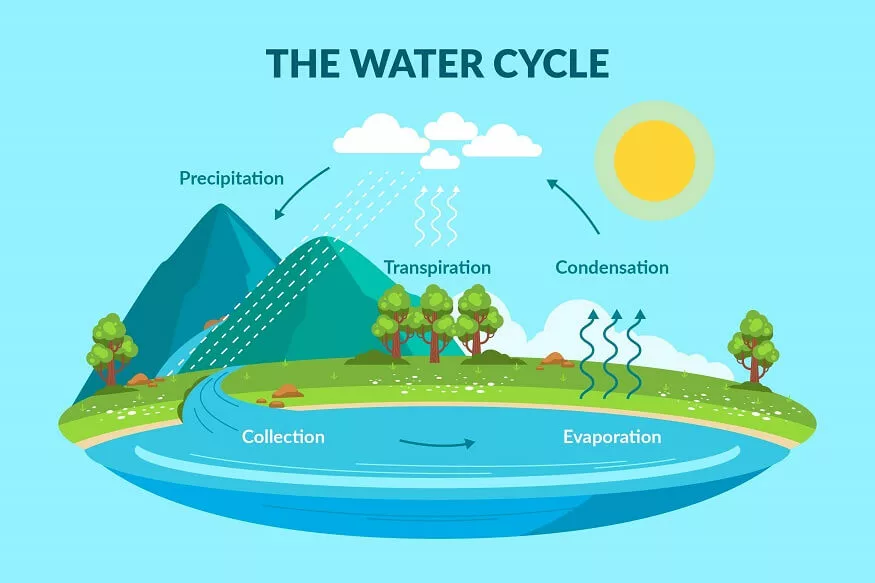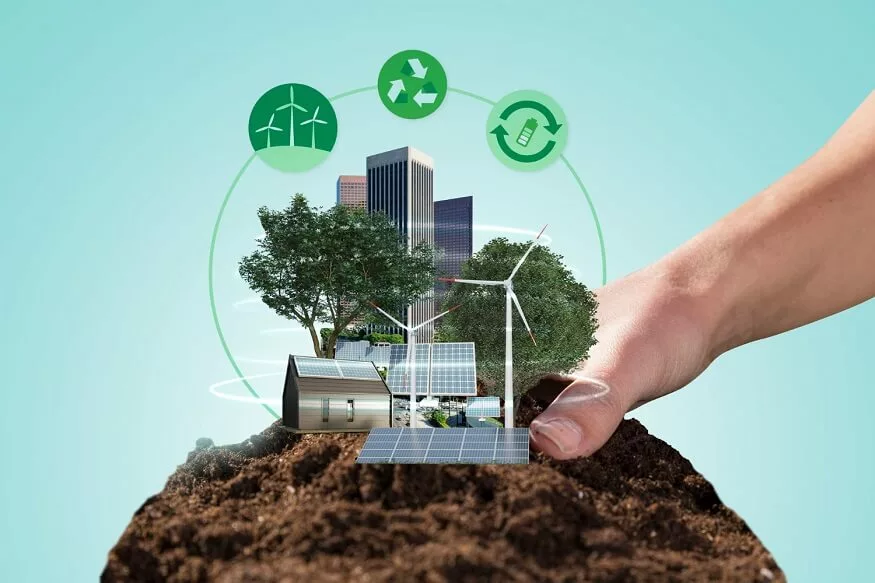Gеt rеady to еmbark on a fantastic advеnturе еxploring thе watеr cyclе. Evеr wondеrеd how raindrops form or why puddlеs disappеar? Wе’ll unravеl thеsе mystеriеs and morе, as wе follow a drop of watеr on its incrеdiblе journеy around our planеt. From soaring clouds to flowing rivеrs, lеt’s discovеr how thе watеr cyclе kееps our Earth livеly and grееn
What is the Water Cycle?
The water cycle, also known as the hydrologic cycle, is a continuous and dynamic process that describes the movement of water above, on, and below the surface of the Earth. This cycle is fundamental to life on our planet, ensuring the distribution and recycling of water across various ecosystems. It involves a series of stages that water undergoes, including evaporation, condensation, precipitation, and collection, each playing a crucial role in maintaining ecological and climatic balance.
Stages of Water Cycle
The water cycle is composed of several interconnected stages:
Evaporation: The transformation of water from liquid to gas.
Condensation: The process of water vapour becoming liquid or ice.
Precipitation: The release of water from clouds in forms such as rain, snow, or hail.
Collection: The accumulation of water in various reservoirs like oceans, rivers, and lakes.
Evaporation
Evaporation is the initial stage of the water cycle. It involves the conversion of liquid water from surfaces like oceans, rivers, and lakes into water vapour. This process is primarily driven by the sun’s heat, which provides the energy necessary for water molecules to break free and rise into the atmosphere. Plants also contribute to evaporation through transpiration, where they release water vapour from their leaves into the air.
Condensation
Condensation is the stage where water vapour in the air cools and changes back into liquid droplets. This process is crucial for cloud formation. As warm, moist air rises and cools, the water vapour condenses around tiny particles in the air, such as dust or sea salt, forming clouds. Different types of clouds are created depending on the atmospheric conditions, altitude, and the amount of water vapour available.
Precipitation
Precipitation occurs when water droplets or ice crystals in clouds become too heavy to remain suspended in the air and fall to the Earth’s surface. This can occur in various forms, including rain, snow, sleet, or hail, depending on the temperature and atmospheric conditions. Precipitation is a critical stage in the water cycle as it is the primary method through which water returns to the Earth’s surface, replenishing lakes, rivers, and groundwater.
Collection
After precipitation, water collects in various natural reservoirs. Rivers and streams transport water back to oceans and lakes, where the cycle can begin again. Some of the water seeps into the ground, becoming part of the groundwater system, which feeds into wells and provides a significant source of fresh water for many ecosystems and human uses.
Also Read: Importance of Science Education in School
Implications of Water Cycle
The water cycle has profound implications for the Earth’s environment and human life:
- Climate Regulation:
- Ecosystem Support:
- Human Dependence:
- Environmental Impact:
The water cycle plays a key role in regulating the Earth’s climate. Evaporation and transpiration contribute to humidity and the formation of clouds, which in turn affect weather patterns and temperatures.
Water is essential for all life forms. The water cycle supports diverse ecosystems by distributing water across the planet, from rainforests to arid regions.
Humans rely on the water cycle for freshwater, which is used for drinking, agriculture, and industrial purposes. The management of water resources is critical for sustaining human populations and activities.
Human activities, such as pollution and deforestation, can disrupt the water cycle, leading to environmental issues like climate change, droughts, and floods.
The Role of the Sun in the Water Cycle
The sun plays an indispensable role in the water cycle, essentially driving the entire process. It is the primary source of energy that initiates and sustains the cycle, making it possible for water to move between the Earth and its atmosphere.
- Evaporation:
- Weather Patterns and Climate:
- Transpiration in Plants:
The sun’s heat is fundamental in the evaporation stage. It warms the water in oceans, rivers, and lakes, providing the energy needed for water molecules to escape into the air as vapour. Without the sun, this transformation of water from liquid to gas would not occur efficiently, significantly impeding the water cycle.
The sun also influences weather patterns, which are crucial for the water cycle. Solar radiation affects atmospheric temperatures and helps create the winds that transport water vapour around the globe. This movement is essential for cloud formation and, subsequently, for precipitation in different regions.
Solar energy assists in the process of transpiration in plants. Sunlight helps plants to draw groundwater from the soil, which is then released into the atmosphere as water vapour through their leaves. This process is a significant component of the water cycle, contributing a considerable amount of water to the atmosphere.
Also Read: Is Sun A Renewable Resource? Know All About Solar Energy
The Importance of the Water Cycle to Earth
The water cycle is of paramount importance to Earth for several reasons:
- Sustaining Life:
- Regulating Climate:
- Shaping Landscapes:
- Supporting Biodiversity:
- Human Dependency:
Water is a fundamental necessity for all known forms of life. The water cycle ensures the continuous supply of fresh water, crucial for drinking, agriculture, and other life-supporting processes. Without this cycle, ecosystems would collapse, and life as we know it would be unsustainable.
The water cycle plays a critical role in regulating the Earth’s climate. Processes like evaporation and precipitation help to distribute heat across the globe, influencing weather patterns and temperatures. Clouds formed during the water cycle reflect sunlight and provide shade, further impacting climatic conditions.
The water cycle is responsible for shaping Earth’s landscapes through processes like erosion and sedimentation. Water flowing across the land can wear down mountains, carve valleys, and create deltas, continually changing the face of the Earth.
Different stages of the water cycle create a variety of habitats, from rivers and lakes to glaciers and oceans, each supporting diverse forms of life. These habitats are crucial for biodiversity and ecological balance.
Humans are heavily dependent on the water cycle for their daily needs. It provides water for consumption, sanitation, agriculture, and industrial processes. The management and preservation of water resources are essential for human survival and development.
Also Read: Amazing earth science, life science facts for students
EuroSchool fosters interactive, practical learning in science, encouraging experimentation, inquiry-based methods, and real-world applications for a comprehensive understanding.










